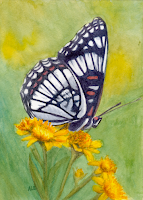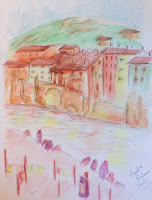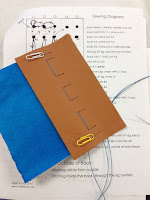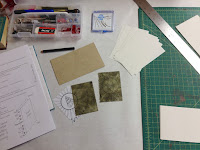I made three sizes of leather books. The smallest leather books were based on the
Quote books I had previously made. Because I used 90 lb Stone henge paper, there were fewer folios in each signature of these books. I printed inspirational quotes in a speech bubble on cloud paper for the books endpapers. Mother of perl or vintage buttons were used for the book closures.
You can see an examples of the bookmark tags I used on the photo to the right and the pocket and travel book photos below.
Instead of using my
wooden handled bookbinder's awl, I used a
potters needle tool to punch holes in the signatures for these books. This tool creates holes that are very uniform in size through the whole signature. This is important when you are punching a thick stack of paper.
For the leather covers I used my
Japanese hole punch. This is a wonderful tool for punching leather, as holes created by an awl close up quickly making it harder to sew the the signatures in place.
The medium sized pocket leather books were done with a
locking and varied long stitch binding. For the 98 page text block I used Neenah 32 lb paper. I used recycled nature calendar photographs for endpapers, as seen in the photo to the left. These books have either traditional leather straps or handmade raku button closures. An example of each type of closer is in the photo to the left.
These soft leather books open flat making it easy to write and sketch on the pages.
For the large traveler's leather books I used an
earlier link and long stitch pattern that has a central diamond on the spine. The endpapers for these books were recycled maps from an old atlas I purchased at a local library book fair. I used maps that featured North America, which just seemed perfect for these books. Below is a photo showing the front endpaper map of one the books.

I added calendar photographs that coordinated with each book's maps to other signatures in the books. The space between the signatures of these books allows for adding envelopes and other items collected while traveling.
I used traditional leather straps or buffalo nickel concho with twisted cords for closures. The maps and photographs are to inspire travel to new and wonderful destinations.



















































